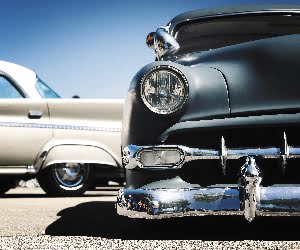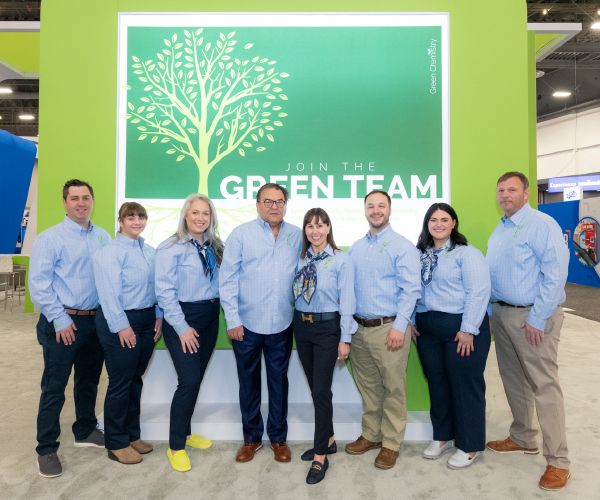
Blast from the Past - Summer 2014
April 2, 2014
6 minute ReadWe occasionally provide excerpts from The Great American Car Wash Story. Former ICA Executive Director Gus Trantham and veteran commercial writer John Beck wrote this book in 1994. It represents the most complete history we have found of the industry in North America. Enjoy.
Chapter 60
CAN THERE BE A TRUE TOUCHLESS?
Whenever the terms “touchless” or “frictionless” are used in car washing, they are no doubt intended to mean the banishment of brushes of all kinds, even “soft” cloth brushes.
Yet many experts in the business have said, and some are still insisting, that there must be some kind of friction to remove many kinds of dirt.
That veteran, John Jurkens, who was pioneering ways of using combinations of water spray and chemicals as far back as the early ’50s, confesses that it is still difficult to break through the film without some kind of friction.
Beth John and Robin King recall an expensive experiment in the ’60s when John Blassim and Jerry Mackinlock of Milwaukee, Wisc., tried to eliminate the need for brushes, and still get friction, through the use of sawdust to wash cars.
This team had called it the Hydro Cellulos System, which employed large pipes to spray wet sawdust on cars and then rinse them off at the rate of about 3,000 gallons of water per car.
Learning about this, Robin King wrote an article on the subject, but it wasn’t long before disaster had struck. While the system did an excellent job of cleaning, it was found that the sawdust got into the car doors, weighing them down with wet sawdust and making it impossible to operate the windows. This resulted in so many lawsuits as to soon put the Hydro Cellulos people out of business.
Dr. Heinike, back in 1964, had attempted to use pulsing jets of water in his Heicarmat to eliminate the use of brushes. It sounded like a great idea, employing jets of water that vibrated off of the car surface. But, like the sad saga of the soggy sawdust, the Heicarmat soon hit the mat for good.
But the dream of the frictionless wash just wouldn’t die. In an exhaustive article in the June ’84 issue of Professional Carwashing magazine entitled: The Frictionless Carwash – Is the Chemistry Finally Right? the editor, Ray Shear, started by spelling out the dream:
“Washing cars with the use of advanced detergent and less friction has been an idea which has intrigued some serious operators, equipment manufacturers and product suppliers for many years. It now seems likely that the vehicle cleaning industry is experiencing the first wave of change, which signals major innovations in this area.
“In a strictly historical sense, the frictionless wash has already arrived with individual entrepreneur operators up and running with systems of varying types. They report amazing results, which seems to indicate that — if given the option — the buying public will respond with overwhelming approval, and this one important fact could herald an evolutionary change in the automatic vehicle cleaning industry.”
As Shear was to point cut in his article, it has been generally agreed for a long time that efficient cleaning requires a combination of the following five factors:
1. Proper water volume at sufficient pressures.
2. An efficient detergent solution.
3. Proper solution temperatures.
4. Enough dwell time to give solutions a chance to penetrate and loosen the dirt films and deposits.
5. Some kind of agitation to lift away the loosened dirt.
The big debate would seem to center around the word “agitate,” what this really means and how it is to be achieved. A dictionary definition of the word agitate is “to move with violence or sudden forcefulness,” whereas “friction” is defined as “the rubbing of one object or surface against another.”
As that pioneer John Jurkens expressed it in an interview that he had with Ray Shear:
“What we’re striving for is the perfect car wash. I’ve been experimenting with this idea for over 20 years, and I believe that we’re zeroing in on the answer. When you get involved with this type of thing, you have to change your thinking. The important thing to realize is that it’s a system not just a piece of equipment. The system is a combination of applications of various chemical products, which break down the bond that causes the film to adhere to the finish of the car. And then to totally remove the residue.”
One thing that had been disturbing Jurkens was the negative aspect of advertising that used such words as “brushless” and “touchless” as though to imply that the present state of car washing wasn’t safe for cars. He said:
“This can be very confusing to the public, especially because — in my opinion — the average customer doesn’t like to see brushes attacking his car.”
Regardless of the debates pro and con friction, practically everyone would probably agree that the ideal situation would be one in which nothing touches the car surface except water, washing solutions and air.
One person who believes this with a passion, and whose name is being heard more and more in car washing circles, is Dr. Joseph Enning, who built his first conveyor type car wash in Dusseldorf, West Germany, in 1963. Not satisfied with the traditional brush systems, Dr. Enning flown to Albuquerque to pay John Jurkens several visits in so as to learn about his power washing system.
This finally led to Dr. Enning coming to the United States to develop what he calls his “Touchless Carwash,” which in turn has resulted in his joining hands with Ron Bell of Southern Pride in Burlington, N.C., in their joint formation of the International Autowash System company.
When interviewed about the key to the effectiveness of a touchless car wash, Ron Bell answered with the one word, “Robotics.” He likens it to a high-pressure self-service car wash where the nozzle can be safely held as close as possible to the car body surface. This requires the use of computers and photoelectric cells employing infra red light, which can see through the water being sprayed.
Can the true key to “touchless” be in robotics under the control of computers? Is this the trend toward the future? It might be appropriate to recall the words of James Baker, executive vice president of General Electric, who once commented acidly on the need for progress in American industry by saying:
“Our machines are old. Our processes are primitive. Our quality and productivity are a disgrace. American industry faces three choices: automate, emigrate or evaporate.”
When asked exactly what it was he had in mind, Baker explained the need to automate through the use of robots, saying in a few cogent words:
“What makes robots unique is their programmability. Most machines are designed and built for specific tasks, but then if a factory changes the design of its products, it must retool, dismantle existing machines, and install new ones. This is costly and time consuming. A robot, in contrast, is flexible. Hundreds of different programs — each calling for several hundred steps in sequence — can be stored in the robot’s computer brain. As a result, the same robot can work on scores of different items.”
From the words of this industrialist, it is easy to conclude that the robot can be used in a car wash to adapt such car wash equipment to the configurations of almost any vehicle, new or old, large or small. And this would make it possible to locate the nozzles as close as possible for maximum effectiveness in achieving touchless agitation.
Quite understandably, there are many who resist this trend toward replacing humans with computers and machines. Perhaps it would be well to consider the words of Professor Edward Fredkin of the Massachusetts Institute of Technology who said:
“Humans are OK. I’m glad to be one. I like them in general, but they’re only human. It’s nothing to complain about. Humans aren’t the best ditch-diggers in the world.
Machines are. And humans can’t lift as much as a crane.
They can’t fly at all without an airplane. And they can’t carry as much as a truck. It doesn’t make me feel bad.
There were people whose thing in life was completely physical like (that mythical) John Henry and the steam hammer. Now we are all up against the intellectual steam hammer.”
Of course computers and robots are much smarter than steam hammers, but that John Henry of fable was a great guy at swinging a sledgehammer on the railroad, and who sees that done anymore?
Can there be a true touchless? Maybe we are just asking the wrong question. Maybe instead we should ask:
“Has touchless car wash already arrived?”








